by Winding Pathways | Sep 5, 2024 | (Sub)Urban Homesteading, Foraging, Mammals
A few years ago, after seeing many squirrels with nearly naked tails we researched and posted a blog in February 2022. Furless Tailed Squirrels.
The response amazed us. People from around the world visited it and still do every day. We had no idea this condition was so widespread.
So, we’re posting a follow-up. Two winters have passed and our squirrels now have perfectly normal furry tails. We’re unsure if older squirrels have regrown fur or if the new generation never had the condition. Since most squirrels don’t live for more than a few years, we will likely see younger animals.
Whatever conditions caused them to lose their fur seem over. That’s not unusual in wildlife populations. If a serious disease or calamity reduces the population the condition subsides and survivors reproduce with enthusiasm, rapidly restoring abundance.
Based on our website traffic we suspect furless-tailed squirrels have been found far and wide. We predict that they, like our Iowa squirrels, will rebound with healthy furry-tailed animals.
A Short Squirrel Primer
Although many people dislike squirrels for their habit of gobbling up feed intended for birds, we like them. Squirrels are just as fascinating as goldfinches or cardinals, so we put out enough seed for both.
During the 2024 Summer Olympics, we were thrilled watching the graceful and powerful movements of Simone Biles, other gymnasts, and pole vaulters like, Armand “Mondo” Duplantis.
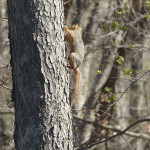
What happens when a squirrel falls?
We’ve not heard of a comparable competition for squirrels, but they are also amazing gymnasts and vaulters. In our yard a small oak and a large walnut live next to each other. Every fall the walnut is loaded with nuts that tempt squirrels. We love watching them climb the oak to its tippy top and then make an amazing upward leap to a flimsy walnut twig above. Like human gymnasts and vaulters, squirrels have impeccable balance, flexibility, strength, determination, and courage.
Treetop leaps aren’t always successful. Twice we’ve seen squirrels slip off high oak branches and fall 30 or 40 feet to the lawn below. Both times the hapless animals spread eagle, landed with a thump, and scampered off apparently uninjured. They are an amazing animal.
Late Summer Activity
As we write this in late summer walnuts and acorns are maturing. People may not like squirrels but these trees need them so much their annual nut crop is a bribe. Squirrels eagerly gather and eat many of the nuts but they scamper off and bury some, often a long way from the parent tree. Some nuts are never dug up and become a new tree generation. The exchange is a good deal for both trees and squirrels.
The rodents get nutritious food. Walnuts and acorns get free tree planting. Both win.
Hopefully, anyone reading this is enjoying squirrels that have grown fur on their once furless tails. Enjoy these amazing animals. To learn more about squirrels visit Animal Diversity.
by Marion Patterson | Aug 29, 2024 | (Sub)Urban Homesteading, Foraging
Eatin’ Weeds
We don’t just pull weeds. We eat them!
Every summer gardeners spend hours pulling, digging, and spraying weeds that pop up overnight and grow like – Weeds! Marion’s family, especially grew up eatin’ weeds. Raised on a small, hardscrabble New Hampshire farm where the biggest crop was rocks, her family of seven supplemented produce with wild foods. Her dad, of the Depression era, knew the wild plants. So, she grew up eatin’ weeds and picking wild berries.
At the nature center in Kansas Rich was always looking for unique programs to present and wild edibles were a hit. Using the Euell Gibbons and Adrienne Crowhurst wild food guides, we learned which foods have the highest returns: easy to gather and process, moderately difficult yet rewarding, and survival-only foods.
We also realized that many are as tasty and nutritious as intentionally planted crops.
Dozens of weed species are edible, but we especially enjoy eating lambs quarter, purslane, and Asian dayflower that we haven’t planted but harvest from our garden. All were introduced from faraway continents and have gone wild. Each is easy to identify.
Lambs quarter
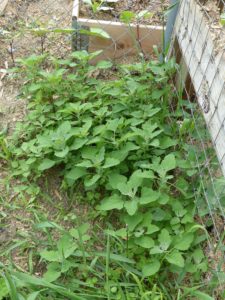
Lamb’s Quarters readily grow in disturbed soil.
This Eurasian native plant has many names. It’s sometimes called lamb’s quarters, goosefoot, or pigweed and has the scientific name Chenopodium album. Lambs quarter is a fast-growing annual weed that we first notice in early spring. We pick and eat it about the same time in April that we plant spinach and lettuce. We keep picking and eating the new shoots as the season advances.
Identification and Preparing
Lambs quarter is easy to identify. One characteristic we like is the leaf’s ability to shed water. Dunk a leaf in water and it looks silvery. Like most wild and garden greens, Lambs quarter is best when picked young and tender. We wash and steam it for a few minutes, much like we cook Swiss chard. Topped with melted butter, it’s delicious. Very young leaves can be rinsed and eaten raw in salad.
Asiatic Dayflower
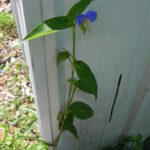
Likes partial shade.
Since lambs quarter is wind pollinated its flowers aren’t showy. That’s not the case with Asiatic dayflower. Its sky-blue blooms last only a single day but add color to our garden. It prefers living in partial shade and thrives under our rain barrels and alongside raised beds in the garden. Botanists call it Commelina communis.
Like lambs quarter, the young leaves and stems are delicious in a salad or can be lightly steamed.
Purslane
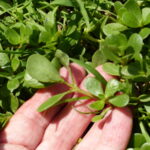
Cultivated world wide
Although Americans constantly pull weedy purslane from their gardens, it is actually a planted crop in India and the US Southwest. Native to the Mediterranean region, it was introduced around the world centuries ago. Purslane is a fleshy plant with the scientific name of Portulaca oleracea.
Purslane grows like crazy and loves hot soil and full sun. It’s somewhat mucilaginous and tends to be gritty. Well-washed young stems and leaves can be eaten raw or steamed. The plant is high in oxalates, so people with kidney problems may want to avoid eating it.
Foraging and Safety
In this era of high food prices families seek ways to trim the grocery bill. Gardening helps and a small flock of backyard chickens adds delicious eggs, but foraging wild foods is becoming increasingly popular.
There are cautions. Many plants have lookalikes that could be inedible or even toxic.
Fortunately, the Internet is loaded with reliable information that helps a novice identify edible plants and learn how to harvest and prepare them for the table. Plenty of printed books are available, but the very best way to learn is to find a skilled forager and tag along on a collecting spree.
Cardinal Rule and Cautions
A cardinal foraging rule is to identify any new plant by at least three sources before attempting to eat it. Don’t take our word for it. If you want to try the plants we mention above, double check identification and edibility on at least two websites, books, or with an expert person.
Cautions. Most people may be able to enjoy eating a certain plant but you may be allergic to it. So, for the first meal or two eat a new food sparingly to make sure no unpleasant symptoms arise. Also, avoid picking plants that may have been sprayed or are alongside a road or near a factory where they might be contaminated by emissions. If you want to go on private property, always have landowner permission before collecting. In public parks make sure picking or gathering is permitted before picking.
Resources
Books:
Euell Gibbon’s classic Stalking the Wild Asparagus got us started on foraging decades ago.
A comprehensive modern book is Nicole Apelian’s Foragers Guide to Wild Foods.
Adrienne Crowhurst’s classics, The Weed Cookbook and The Flower Cookbook were staples in Marion’s family.
App: An app that helps identify edible and nonedible plants is SEEK by iNaturalist.
Websites: There are many. Often a good way to use a website is to first identify a plant and then GOOGLE it. Usually, that will lead to sites that further help identify the plant, give its history, and tell whether it is edible or toxic.
by Winding Pathways | Aug 22, 2024 | Garden/Yard, Nature, Wonderment
Guest Blogger – Jacqueline Hull
Have you ever tried something fun as a gardener? Well, I have. My curiosity wondered if it were possible to root the head of a pineapple.
We love fresh pineapple. The head has to be cut off then the sides to get to the juicy pieces. Then, we stash the severed pieces in the compost pot for future use in the garden.

Will the pineapple take?
One day, after my husband, Peter, dissected our fresh pineapple, I retrieved the top piece and placed it into some moist potting soil. I made sure the soil was damp each day as I waited for it to root. After a time, to my delight, I discovered the head had indeed grown roots and was holding tightly to the soil.
For several years I fertilized and watered this pineapple as the spears grew larger and taller. I also transplanted it to a huge glazed pot.
Peeking down into the center of the plants one day, I saw a teeny tiny fruit that had developed. It kept growing and growing and eventually, a soft, golden color appeared in its greenery. It had about seven inches of fruit and I knew it was ready to be picked.
To our delight when we harvested the pineapple, the inside was sweet and juicy.
Now, we wait for the two that are growing on the porch to ripen. One has a fruit and we anticipate the other to develop its fruit.
Our adventure continues as we try to grow onions from pieces with roots and wonder if we could do the same with celery…maybe!
Editor’s note: Share your growing experiments with us on the comments page.
by Winding Pathways | Aug 15, 2024 | (Sub)Urban Homesteading, Chickens
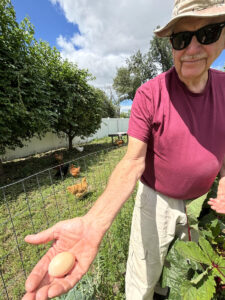
First eggs are a delight to find.
August 26th brought an unexpected and delightful surprise. We found an egg in our coop! Bringing the garden season’s first tomato, cucumber, or summer squash into the kitchen is always an event to celebrate, but it doesn’t compare to the excitement of finding the first egg.
We were expecting eggs soon, but not so soon. Our tiny baby chicks arrived from Hoover’s Hatchery on April 10th. It normally takes a female chick about 20 weeks to mature and lay her first egg. Some old-fashioned breeds don’t start laying until they’re 24 or even 30 weeks old.
We expected our small flock to start laying around Labor Day, but our first egg came when one of our pullets, or young hen, was only 18 weeks old. It was surprising.
Odd Shapes
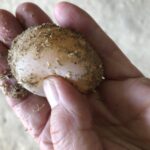
Sometimes calcium does not form on eggs.
A hen’s first eggs are small and sometimes shaped oddly. Sometimes these early eggs can be found in stores marked as, “pullet eggs”. After a few weeks of laying, her eggs reach medium or large size. Sometimes early in a hen’s laying life, she’ll lay a whopper of an egg with two yolks. It’s startling to crack an egg into the frying pan and discover that second yolk. As her reproductive system matures her eggs will be more uniform in size, shape, and have hard shells, and eggshell tint.
Best Breeds
Hundreds of chicken breeds have been developed since the species was domesticated thousands of years ago. They come in a vast array of size, feather color, temperament, and productivity. The best breed is the one its owner likes.
Our 12-hen flock at Winding Pathways is a mix of egg laying superstar breeds and traditional breeds that don’t lay at a furious pace. We like them all. It’s hard to beat Rhode Island Reds, Barred Rocks, or California White breeds for early and plentiful eggs. We have a few but round out our flock with Brown and White Brahmas, Mystic Onyx, Buff Cochins, and a Rainbow.
Fall Chicks
Most families buy chicks in the spring, but fall is also an ideal time to start a flock. Babies hatched in September begin laying by January or February’s baking season.
For detailed information on breeds and chicken care visit Hoover’s Hatchery Website.
It includes blogs filled with tips and Facebook Live Videos filmed at Winding Pathways.
by Winding Pathways | Aug 8, 2024 | (Sub)Urban Homesteading, Foraging
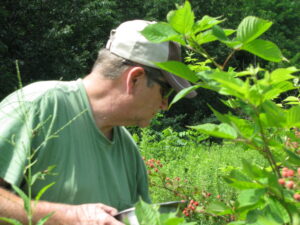
Summer foraging
Rich enjoyed foraging blackberries on an August morning. We love harvesting and eating wild foods gathered on our property at Winding Pathways and in area parks. Every once in a while, our foraging forays yield a bonanza. That is what happened on Rich’s walk. Fortunate Foraging Blackberries
Just after rounding a bend on a Wanatee Park trail, he spotted a patch of wild blackberries. We love them, but they aren’t a reliable food source. To yield juicy fruit the thorny plants need regular rain. In most years the canes sprout springtime blooms that transform into tiny fruits. Then comes a dry spell and the promising fruit dries into inedible seeds.
It’s been years since we enjoyed abundant blackberries, but 2024’s frequent rain promised a heavy crop. That’s what Rich found on his morning walk. Canes were loaded with berries that came with picking bonuses. So many were ripe that picking was easy and the hordes of hungry mosquitoes that normally guard the fruit must have had the day off. Picking in an unusual August cool breeze was a pleasure.
Species of Blackberries
Wild blackberries of several species grow across much of the United States. Most ripen in mid-summer. They thrive in sunny clearings and often quickly colonize when trees blow down or are harvested. A 2020 derecho felled thousands of trees in our area, letting the sun reach soil that had been in the shade for decades. Black raspberries and blackberries began growing the next year, as if by magic, but summers were dry so they didn’t make a crop. Four years after the storm and eight inches of July rain produced an amazing crop.
Unlike many foraged foods that have toxic lookalikes, there are no harmful plants to confuse with blackberries. It is an ideal wild food for novice foragers to start with.
Eating Blackberries
We love eating fresh blackberries. Add a dribble of milk and maple syrup to a bowl and enjoy them. They’re delicious in oatmeal and freeze well. A friend makes the world’s tastiest blackberry pie that’s yummy when served with vanilla ice cream.
Rich encountered a man who’d picked at least two gallons of the small fruits. “What do you do with them,” he asked, and the fellow picker responded:
“I put them in a big pot with some water and sugar and boil it until the berries soften. Then I run them through a cheesecloth filter to remove the seeds and skin. I let it cool down, invite friends over, and mix vodka into the berry juice. It’s just delicious!” he enthused.
Information on blackberries can be found online or in printed books, but a fun website is Spoon University. It’s loaded with foraging information from a young person’s perspective.
A Picking Tip
Blackberry canes are armored with fierce thorns. Hungry mosquitoes often pounce on human pickers. Wear long-sleeved pants and a sturdy shirt. Bring along insect repellent.
Have fun picking and eating a delicious wild bounty of the land.
-
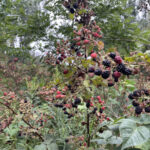
-
Abundant crop
-
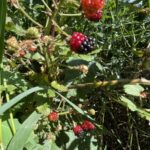
-
Interesting ripening
-
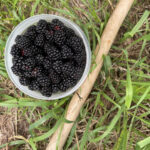
-
Delicious container
by Marion Patterson | Aug 1, 2024 | Garden/Yard, Mammals, Pests
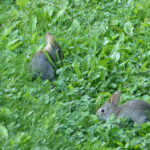
Young rabbits “play” to gain skills and show dominance.
Have you noticed the abundance of the cottontail rabbit this summer? While they can create mischief as in eating desired plants, they also are fun to watch.
Winding Pathway’s resident cottontail rabbits give us delightful evening entertainment. Shortly after sunset, a few appear like magic from out of our labyrinth’s tall prairie. As we sit on our porch they scamper about, chase each other, and nibble on the white clover poking out of our lawn.
Many people dislike cottontails for their habit of feasting on favored garden plants and gnawing on tree bark in the winter. Because we enjoy both rabbits and Swiss Chard, we keep them away from our vegetables and, thus, appreciate their antics.
Several cottontail species range across most of the United States, southern Canada, and South America. They’re well adapted to thrive in diverse environments. Ours is the Eastern Cottontail rabbit. This year they are especially abundant.
There are Rabbits and Then There are Rabbits
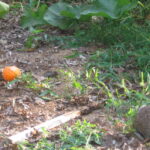
Side by side
Cottontails and common domestic pet rabbits may look similar but they are vastly different.
Pet Bunnies
Pet bunnies trace their ancestry to Europe and were domesticated thousands of years ago. They make fascinating and loveable pets and thrive in a safe roomy hutch eating commercial pellets. These are the rabbits that were released in Australia and caused enormous agricultural and ecological damage. They readily breed, are social, and join others to dig a series of burrows called warrens. Some readers may remember the award-winning novel, Watership Down, and the Netflix series about precocious rabbits.
-

-
Children and adults enjoy bunnies.
-

-
Rabbits are social.
-
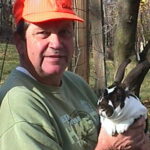
-
Friendly pets
-
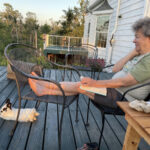
-
European rabbits adapt to people
-

-
Show animals.
-

-
Children with rabbits
Cottontail Rabbits
Cottontails, in contrast, are wild animals that rarely, if ever, become tame or make good pets. Like European rabbits they are social and like the company of other bunnies but not people. Cottontails don’t make burrows but sometimes enjoy ducking down an abandoned woodchuck hole. Cottontails live under dense vegetation, in culverts, and under outbuildings. They eat a wide range of wild plants but love snacking on vegetables. In winter they sometimes eat the bark off young trees. So, be sure to protect your young trees with wire mesh around the base.
-
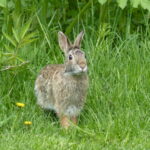
-
Time for an evening snack.
-
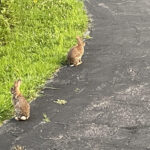
-
bunny play
-
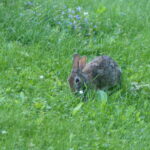
-
Nibbling clover
Enjoying Both Cottontails and Vegetables
Years ago, we learned a trick that lets us enjoy our resident cottontails and abundance from the garden. European rabbits are high jumpers, but not cottontails. Instead, native bunnies are long jumpers who can’t jump high. Just a wimpy two-foot-tall chicken wire fence around the garden or a young tree keeps them away as long as they can’t get under it.
-
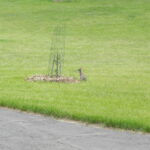
-
Keep rabbits away from young trees.
-
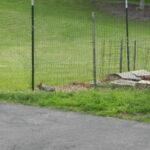
-
Cottontails cannot jump high.
Why So Many Cottontails This Year
For the past few years, Iowa has been in drought. It limited the new tender growth of clovers and other delectable plants that bunnies love. Sparse rain thinned thickets where they hide. This year’s been wet. Vegetation is tender and abundant yet we’ve not had big early thunderstorms. Why’s that important to a cottontail?
Before giving birth, a cottontail digs a shallow hole in the ground, often near the edge of a lawn. She lines it with fur and soon deposits three to eight tiny blind helpless babies. Mom mostly stays away but nurses them in the morning or evening by sitting over the burrow and letting her babies nurse. They grow amazingly fast and are out on their own when only about three weeks old. Mom soon gets ready for another litter.
Who Doesn’t Love a Cottontail Rabbit?
Predators love rabbits. They’re a favorite meal for dogs, cats, raptors, snakes, foxes, and coyotes. There are always rabbits because their survival strategy is to have many babies, even though only a small percent reach adulthood and reproduce.
Getting Rid of Cottontails
Well, why do it? They are inquisitive and beautiful animals that share yards with people.
An easy solution is to run chicken wire around desirable plants to keep them away. So, people can have their plants and rabbits, too.
Hooray for bunnies! They brighten our evenings as they scamper about our yard.
-
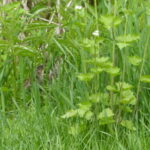
-
Rabbits know to stay hidden
-
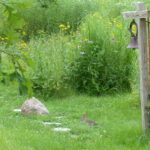
-
Cottontails live in the labyrinth.
-

-
Nibbling clover


























